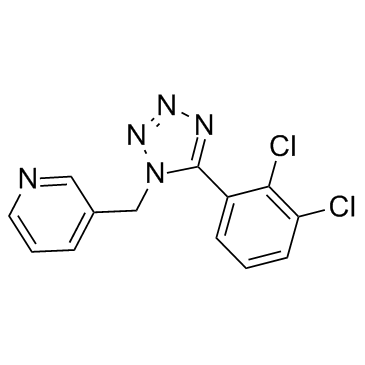| Description |
A 438079 is a potent, and selective P2X7 receptor antagonist with pIC50 of 6.9.
|
| Related Catalog |
|
| Target |
pIC50: 6.9 (P2X7 receptor)
|
| In Vitro |
In 1321N1 cells stably expressing rat P2X7 receptors, A 438079 blocks BzATP-(10 μM) evoked changes in intracellular calcium concentrations with an IC50 of 321 nM. A 438079 is also selective for the P2X7 receptor, at concentrations up to 100 μM[1].
|
| In Vivo |
A 438079 (80 μmol/kg, i.v.) reduces noxious and innocuous evoked activity of different classes of spinal neurons in neuropathic rats. A 438079 (100 and 300 μmol/kg, i.p.) significantly raises withdrawal thresh-olds in both the SNL and CCI models[1]. Intraperitoneal injection of A 438079 (5 and 15 mg/kg) 60 min after triggering seizures reduces seizure severity and neuronal death within the hippocampus. A 438079 has superior neuroprotective effects compared with an equally dose of phenobarbital (25 mg/kg)[2]. A 438079 partially but significantly prevents the 6-OHDA-induced depletion of striatal DA stores[3]. Pretreatment with A 438079 reduces nociceptive behaviour scores in the HC model[4].
|
| Kinase Assay |
Human astrocytoma cells, 1321N1, are grown to stably express rat P2X7, human P2X4, P2X2a, P2X2/3, P2X1, P2Y1 and P2Y2 recombinant receptors. Agonist, BzATP, 2,3-O-(4-ben-zoylbenzoyl)-ATP or ATP-induced changes in intracellular Ca2+ concentrations are assessed in all of the cell lines using the Ca2+ chelating dye, Fluo-4, in conjunction with a Fluorometric Imaging Plate Reader. The cells are plated out the day before the experiment onto poly-D-lysine-coated black 96 well plates. After the agonist addition, changes in intracellular Ca2+ concentrations are recorded, per second, for 3 min. Ligands are tested at 11 half-log concentrations from 10-10 to 10-4 M. BzATP or ATP concentrations corresponds to the EC70 values for each receptor to enable comparison of antagonist potencies across the multiple P2 receptor subtypes. A 438079 is added to the cell plate and fluorescence data are collected for 3 min before the addition of agonist, subsequently, data are then collected for another 2 min. The pEC50 or pIC50 values are derived from a single curve fit.
|
| Animal Admin |
To confirm A 438079 reach the brain after systemic administration, P10 rat pups are injected with 5 mg/kg A 438079 and killed either 10 min, 30 min, or 2 h later (n=4 per group). Blood samples are centrifuged at 1000×g for 10 min to isolate the plasma. Samples are analyzed using liquid chromatography-mass spectrometry (LC-MS/MS) by a service provider. Briefly, protein is precipitated from 50 μL aliquots of the individual plasma or brain tissue homogenate, and A 438079 is quantified by LC-MS/MS from a five-point standard curve.
|
| References |
[1]. McGaraughty S, et al. P2X7-related modulation of pathological nociception in rats. Neuroscience. 2007 Jun 8;146(4):1817-28. [2]. Mesuret G, et al. CNS Neurosci Ther. 2014 Jun;20(6):556-64. [3]. Marcellino D, et al. On the role of P2X(7) receptors in dopamine nerve cell degeneration in a rat model of Parkinson's disease: studies with the P2X(7) receptor antagonist A-438079. J Neural Transm (Vienna). 2010 Jun;117(6):681-7. [4]. Martins JP, et al. The role of P2X7 purinergic receptors in inflammatory and nociceptive changes accompanying cyclophosphamide-induced haemorrhagic cystitis in mice. Br J Pharmacol. 2012 Jan;165(1):183-96.
|
